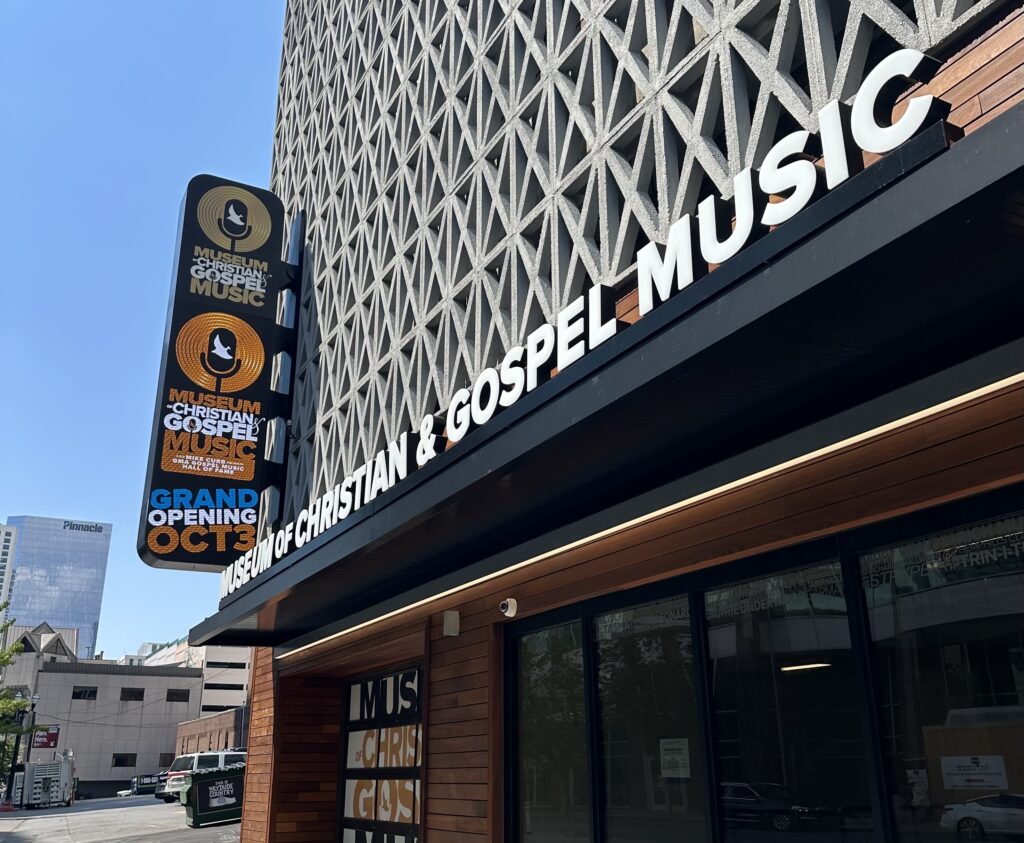
When I visited the Museum of Christian and Gospel Music in downtown Nashville two weeks ago, workers were still installing flooring and very few artifacts were in place.
“You’ll see the cases are not filled yet,” said the museum’s executive director Steve Gilreath, while describing what the displays would ultimately contain. “We’re still building the holders that go with them. These are all precious items.”
The rush to get the place ready to open is a milestone in itself — especially for the institution housed within it, the GMA Gospel Music Hall of Fame. The Gospel Music Association established the Hall in 1971, and it’s since held induction ceremonies and welcomed nearly 200 members. But for those 50-plus years, it’s been without a physical location, a reality that’s relegated it to something of an ephemeral status. That’s finally changing with the museum’s Oct 3 opening.
Getting out of the box
“It has lived in a cardboard box in the basement of the headquarters,” Gilreath emphasized. “And that’s unbelievable and outrageous at the same time.”
It wasn’t for lack of trying, notes Mike Curb, philanthropist and founder of Curb Records. His foundation is funding the Hall of Fame’s glossy, new interactive display, which he considers the realization of a longtime goal: “We’ve been trying for years to get a home.” At one point, Curb and other label executives tried to secure the lot where the Bridgestone Tower now stands for that purpose.
His investment in the Christian music industry dates back to its modern origins; in the late ‘60s, he helped launch some of its influential early West Coast stars, including Larry Norman and 2nd Chapter of Acts.
“I don’t think I fully realized it at the time,” Curb reflects, “but there I was right at the start of what is contemporary Christian music. I was signing these artists as mainstream artists and putting them out just like we would put out a pop or a rock or a country artist. I didn’t have them in a separate Christian category.”
White Southern gospel and Black gospel already existed as wholly distinct genres. And predominately white contemporary Christian music would soon emerge as a commercially viable inspirational analogue to secular pop and rock. (For a phenomenally well-researched account of that complex history, I recommend Leah Payne’s 2024 book “God Gave Rock and Roll To You.”)
When downloading and streaming supplanted record sales across the music industry decades later, the CCM market was hit especially hard. Jackie Petillo became the president of the Gospel Music Association 15 years ago — the first woman of color in the role — and a top priority was to help her industry weather that crisis. She also sought to bring the historically segregated lineages, communities and markets of Christian and gospel music closer together through the GMA’s annual Dove Awards show.
Only after making those moves, could she turn her attention to matters of legacy.
Celebrating Christian and Gospel music in one place
“People automatically assume that there is a place that celebrates Christian and Gospel music somewhere in America, and there isn’t,” Patillo points out.
Pigeon Forge has the Southern Gospel Music Association Hall of Fame and St. Louis has the Gospel Music Hall of Fame. But she envisioned an institution that would unite the histories of those traditions, as well as the relatively recent history of Christian pop, under one roof.
So Patillo approached the board of the Nashville-based GMA, and they commissioned a feasibility study and capital campaign. “This was a 15-million dollar project,” she says. “Once we had the data that Music City did need a Christian and Gospel music museum, it was off to the races.”
Patillo and the GMA already had an arrangement with Lipscomb University to host their offices and the Dove Awards. (After 11 years in Lipscomb’s arena, the awards show will move to a larger venue, Bridgestone Arena, for its 56th edition next week). And now the museum occupies the same building as the school’s downtown Nashville campus.
“It just so happened that there was a little over 11,000 square feet here that they were not using,” Patillo reports. “So we are third-party lessors and we have a 15-year long-term lease to be here. And it’s right in the perfect location. We’re a block behind the Ryman. The Bachelorette pedal taverns go by here. And we’ve got a garage door in the front that we can open up and let the music flow out into the street.”
Think of all the other important musical histories formalized in nearby institutions: the National Museum of African American Music; the Musicians Hall of Fame; the Country Music Hall of Fame and Museum, which includes the glass-roofed Mike Curb conservatory.
Curb has long envisioned what the Museum of Christian and Gospel Music could offer tourists, students and anyone else who pays a visit: “They’re going to be able to see the full history of Christian music. It sort of completes Nashville.”

